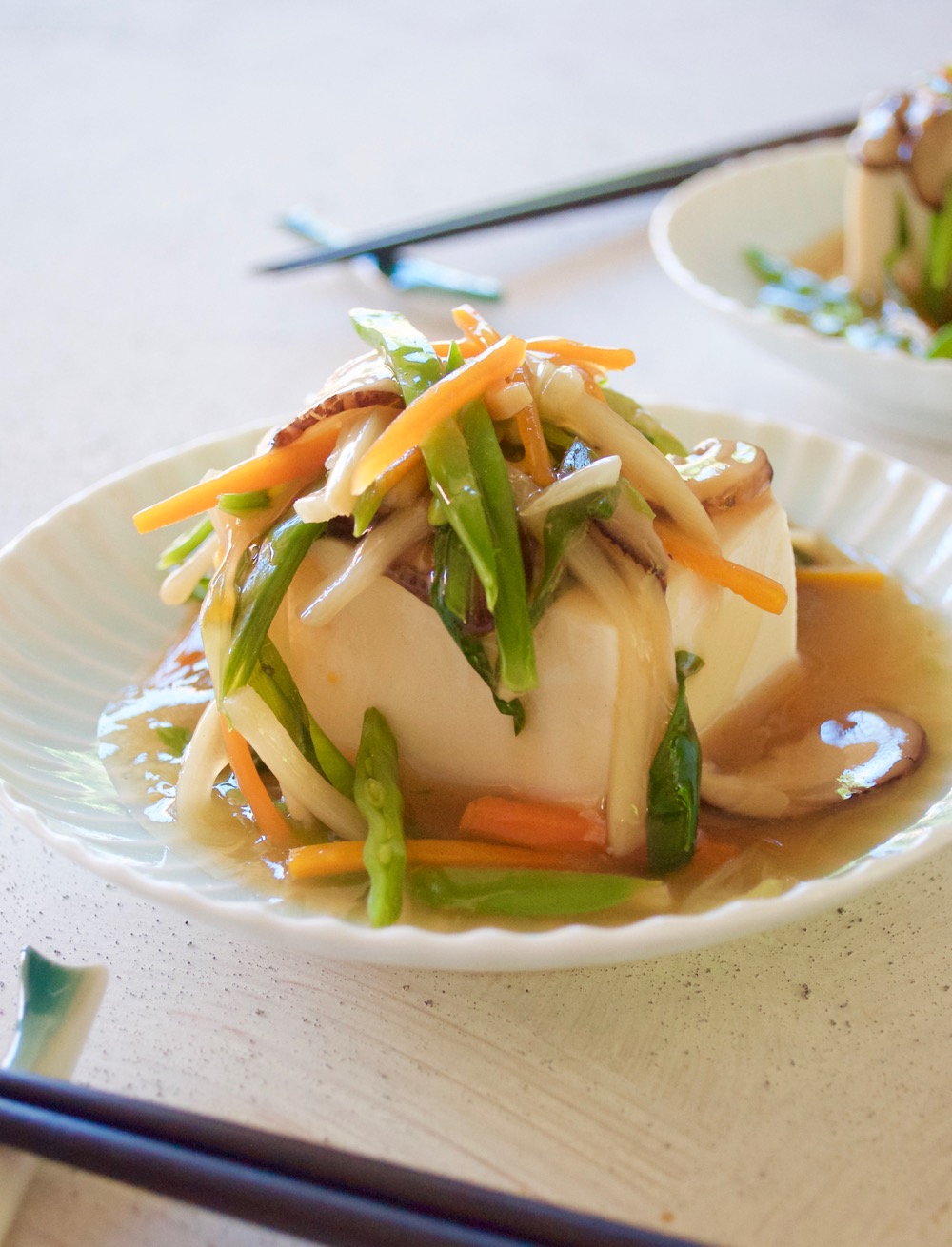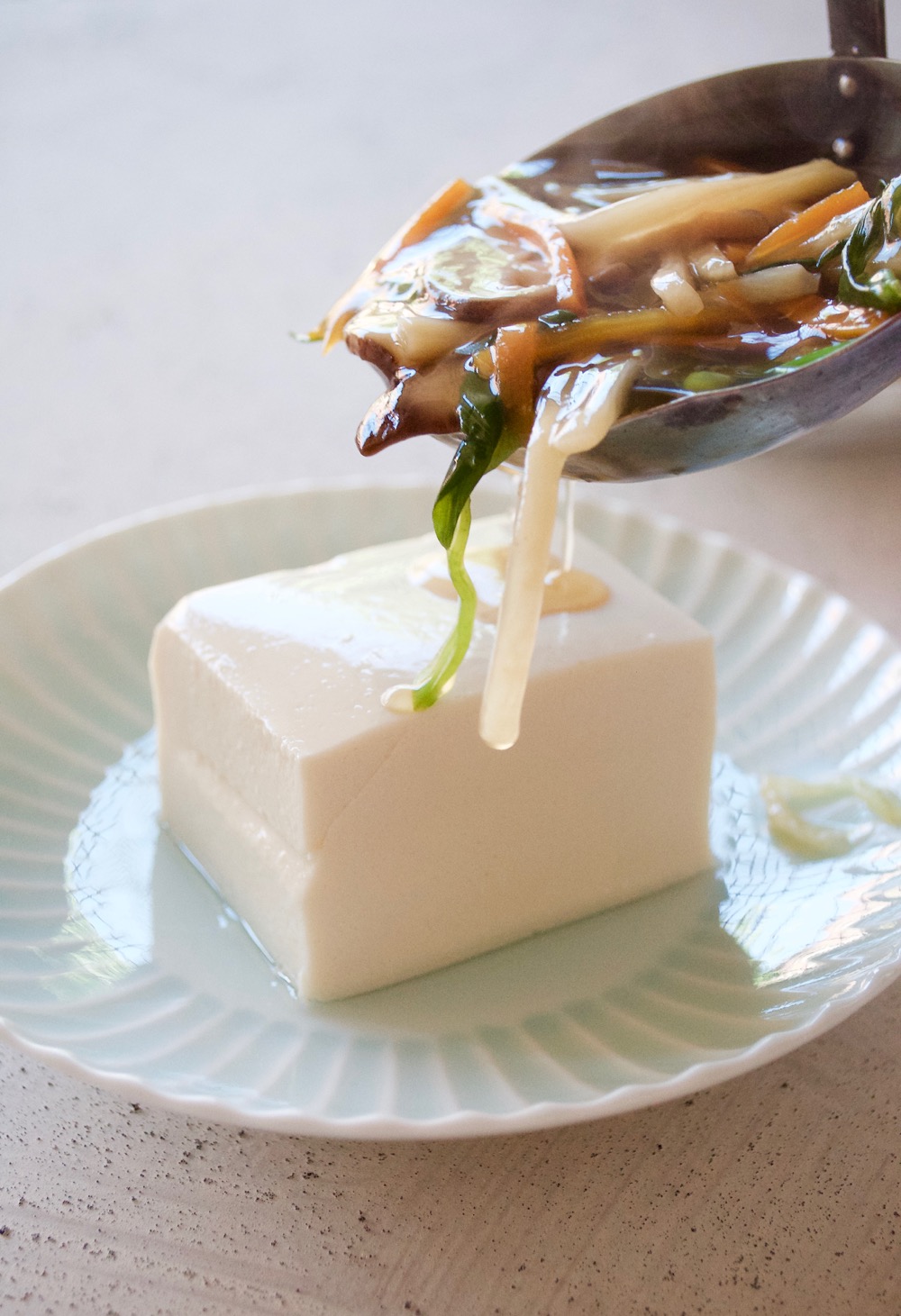Here is a different way of eating tofu with plenty of vegetables in thick sauce. It makes the otherwise a simple tofu so special and pretty.

Tofu (豆腐) is one of the commonly used ingredients in Japanese dishes. It is also called bean curd and is made from soy milk by coagulating it. They are normally sold in blocks but in Japan, I have seen tofu even in a boat shape!
In Japan, hard tofu is called momen-doufu (木綿豆腐) and soft or silken tofu is called kinugoshi-doufu (絹ごし豆腐). Depending on the amount of water left in the curd, the tofu can be made firmer or softer.
In Australia, you can buy tofu at supermarkets and Asian grocery stores. You probably find in the shop all sorts of tofu with different firmness such as Silken Tofu, Silken Firm Tofu, Regular Tofu, Momen Tofu, Firm Tofu and Extra Firm Tofu. I listed these roughly in the order of soft to hard. I say roughly because it all depends on the amount of water which varies by producer and they name tofu differently. But if you see the word ‘Silken’ then you can assume the tofu is kinugoshi-dofu.

In Japanese cooking, dish types suitable for hard tofu are stir fries, simmering or deep frying, while delicate dishes, soups, hot pots or salads require soft tofu. However, people might like the softness of kinugoshi-dfu or hardness of momen-dofu. And therefore they use a particular type of tofu in all dishes unless it is totally unsuitable. For example, kinugoshi-dofu is so soft that using it in stir fry will make the tofu crumble and it will not retain the shape of cut tofu.

Hiyayakko – cold Tofu with toppings
The simplest way of eating tofu in Japan is called hiyayakko (冷奴) which is just chilled tofu with toppings such as grated ginger, bonito flakes, and chopped shallots, served with soy sauce to pour over it. Hiyayakko is the best source of protein in Japan’s humid and hot summers, in my view.
No cooking, just chopping, and chilled food brings coolness to your table. Even here in Sydney during summer time, we have hiyayakko and cold noodles with some vegetables for dinner.
Incidentally, the second simplest tofu dish is one of my posts, Yudofu (Tofu hot pot).
Today’s recipe is also quite easy to make. Tofu is served warm with a tasty thick sauce containing plenty of vegetables. I make this when I am on a diet but need a bit of substance so that I feel like I am eating a proper meal.

I eat this with chopsticks as the photo implies. But if you or your guests are not good with them, I would recommend that you serve this with a spoon. And you might want the vegetables cut a bit shorter so that you can scoop them with a spoon easier.
Yumiko![]()

- 1 pack of silken tofu (note 1)
- ½ cup carrots julienned into 4-5cm (2") long
- 2 shiitake mushrooms , stems removed and sliced thinly
- ½ cup of boiled bamboo shoot strips (note 2)
- A handful of snow peas
- ¼ cup of shallots , finely sliced diagonally
- ½ tsp grated ginger
- 1 cup dashi stock (note 3)
- ½ tbsp mirin
- 1 tbsp sake
- 1 tbsp light soy sauce (note 3)
- A pinch of salt
- 1 tbsp cornflour/corn starch dissolved in 1 tbsp water
-
To prepare the snow peas, snap the tip gently without completely detaching the end from pod. Then pull it along the side of the pod to strip the stringy part of the pod off. Do the other side using the opposite end of the pod (note 5).
-
Blanch snow peas in boiling water with a pinch of salt for 30 seconds, then transfer to a bowl of cold water to stop further cooking. Slice thinly diagonally, making long slices to match the length of the other vegetables.
-
Add dashi stock, carrots, shiitake and bamboo shoots in a pot and cook over high heat. When the vegetables are nearly cooked, add snow peas, shallots and the remaining sauce ingredients excluding corn flour slurry.
-
When the sauce starts boiling, stir in the cornflour slurry to make the sauce thicken. Turn the heat off.
-
Place a pot with water sufficient to boil tofu over high heat. Remove the plastic cover of the pack by cutting it with a knife along the pack. Turn the pack upside down and place it onto your palm. Squeeze the plastic pack to loosen the tofu into your palm. Cut the tofu in half width-wise (along the short axis) into two blocks while on the palm and gently place the tofu in the boiling water one by one.
-
Turn the heat down to simmer gently. When the tofu starts floating or moves lightly, it is ready. Take a piece of tofu out of the water using a spatula or spoon with holes and place it on a plate or a shallow bowl. Pour over the vegetable sauce and serve immediately.
1. The size of tofu in a pack is about 11cm x 8cm x 4cm.
2. I have used canned boiled bamboo shoots strips. You can buy bamboo shoots as a whole shoot, rectangular cut pieces or thin strips. You may also find boiled bamboo shoots in a vacuum pack. If you are using a whole or rectangular pieces, just julienne them.
3. If you are a vegetarian, substitute it to vegetarian dashi which you can find in Varieties of Dashi Stock.
Instead of making dashi stock from scratch, you can buy a pack of dashi powder at Asian grocery stores and just add the powder into water. Please refer to the instruction on the pack of the dashi power for the ratio of powder and water.
4. There are several different kinds of soy sauce in Japan and nowadays you can buy almost all of them at Asian grocery stores or definitely at Japanese grocery stores. Please visit Japanese Dressings where I talked about soy sauce varieties.
5. I know it is very hard to remove the strings on both sides of the pea pod. Quite often, you can only remove one side, sometimes not at all. If you can’t remove the strings, don’t worry. This is just the typical meticulousness of Japanese-style preparation.
I made this last night (on a bed of Asian steamed greens) and both Karl & I loved it!! Such a beautifully flavoured dish, light but that sauce is addictive!
Hi Nat. thank for your comment! I’m glad you and Karl liked it. It’s a great idea to place it on Asian greens.
This sounds perfect for me as I’m recently trying to cut down on meat consumption and replace my protein sources with plant & legume sources 🙂 actually this reminds me of a Chinese style saucy noodle dish usually made with some pork and seafood instead of tofu, but this is with Japanese lighter flavours instead 🙂
I love your blog (as well as Nagi’s) – please do update with more of the homestyle Japanese recipes such as the less known braised and soupy dishes! Thank you.
I have this kind of dishes when I feel like eating a light meal (or when I try to lose weight which is most of the time!).